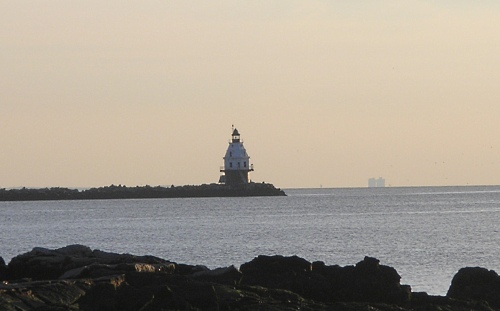Speranza

The Southwest Ledge Lighthouse (also known as the New Haven Ledge Light) was built in 1877.
Southwest Ledge, on the East-Haven entrance to New Haven Harbor, is a dangerous rock
formation blocking the main channel into the Harboir.
The construction of a
lighthouse on the Ledge was considered in 1845, but was too expensive a project
to undertake, due to the site’s isolated location.
Instead, a new tower was
built at that time at Five-Mile Point.
By 1873, technology had developed to the
point that building a lighthouse on the Ledge was feasible and construction
could begin.
That year a storm disrupted the preparations to lay the foundation,
which had to be restarted the following year.
The Lighthouse, designed by Major
George H. Elliott, has a cylindrical foundation, made of iron and filled with
concrete.
It was designed to allow winter ice to float around instead of
building up and damaging the structure.
The lighthouse was designed with Second
Empire style details, including a Mansard roof.
The superstructure, built for
Southwest Ledge in a Baltimore shipyard, was considered such an impressive feat
of engineering that it was put on display at the 1876 Centennial Exposition in
Philadelphia, with an actual lighthouse keeper residing inside. In the end, this
structure was not sent to New Haven but was sent to Delaware Bay and became the
Ship John Shoal Light.
Instead, an identical superstructure was sent to
Southwest Ledge, although, according to some sites, it was Southwest Ledge which
received the original superstructure initially intended for Ship John Shoal,
while the Delaware Bay lighthouse instead received the second structure, after
its stay in Philadelphia.
Put in place in 1876, Southwest Ledge Light was
first lit in 1877.
A new breakwall was soon built, ending at the new lighthouse.
The living conditions for the lighthouse keepers remained bad for many years due
leaking, dampness, bad drinking water and numerous cockroaches.
In these rough
conditions, Assistant Keeper Nils Nilson went into a violent rage and chased
Keeper Jorgen Jonnensen around the tower with a fire axe.
Jonnensen was able to
lock himself in a storage room and Nilson left in a row-boat.
Soon after, in
January 1908, Nilson committed suicide.
Despite this incident, the lives of many
people were saved over the years by the keepers of Southwest Ledge Light. The
Light was automated in 1953 and continues as an active aid to navigation.






No comments:
Post a Comment